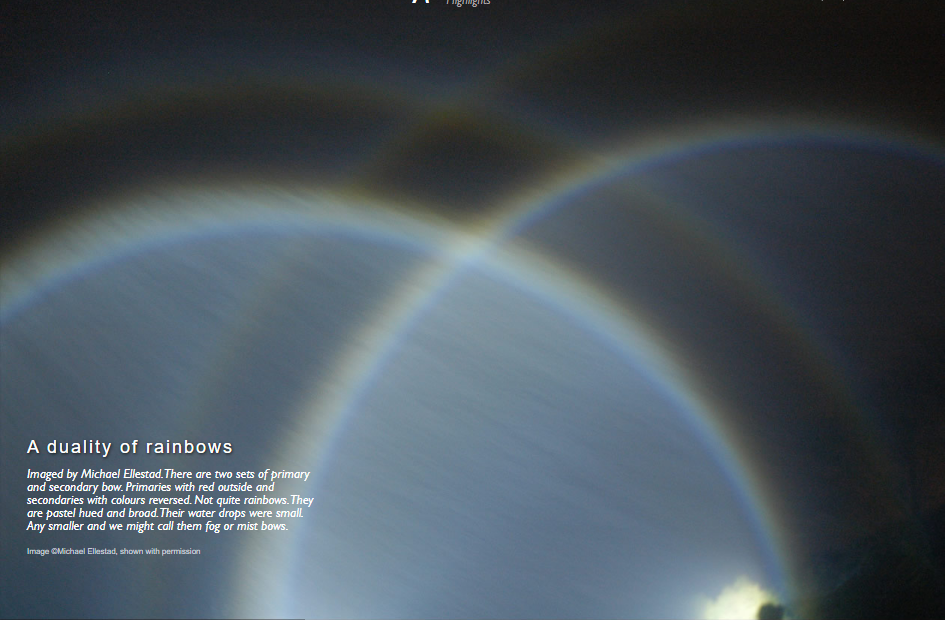A duality of rainbows
A Duality of Rainbows: A Spectacular Atmospheric Phenomenon
Rainbows are one of nature's most enchanting sights, but have you ever heard of a duality of rainbows? This captivating atmospheric phenomenon occurs when two sets of primary and secondary bows appear in the sky. Unlike traditional rainbows, these duality rainbows possess a pastel hue and are broader in shape. Their unique appearance is a result of small water droplets, which, if any smaller, could be mistaken for fog or mist bows.
To capture the beauty of this atmospheric display, photographer Michael Ellestad employed two high-power LED flashlights positioned 2 meters apart. By crossing their beams and placing the camera where they intersected, he managed to capture an image reminiscent of what one might observe on an Earth-like exoplanet orbiting a binary star system, such as Tatooine from Star Wars.
While Tatooine may be out of reach, you can still witness a similar sight right here on Earth. Find a smooth lake, a rain-wet parking lot, or a beach with wet sand. Look towards the opposite side of the sun, and you'll be greeted with a mesmerizing reflection of sunlight from the mirror-like water surface. To a raindrop, it appears as if there are two suns shining, creating the perfect conditions for the formation of two sets of rainbows.
The Science Behind Duality Rainbows
To truly appreciate the splendor of duality rainbows, let's delve into the science behind their formation. Rainbows are formed when sunlight passes through water droplets suspended in the air, causing the light to refract and reflect within the droplets. This bending and reflection result in the separation of white light into its component colors, creating a circular arc of vibrant hues.
In the case of duality rainbows, the two sets of primary and secondary bows occur due to the reflection and refraction of sunlight in two separate sets of water droplets. The primary bow, with its red outer edge, is formed by light entering the droplets and undergoing a single internal reflection before exiting. On the other hand, the secondary bow, with its reversed colors, occurs due to light entering the droplets and undergoing two internal reflections before emerging.
Capturing the Magic of Duality Rainbows
Photographing duality rainbows can be a challenging yet rewarding endeavor. To capture these ethereal displays, it is essential to find the perfect location where sunlight reflects off a smooth water surface. This could be a calm lake, a puddle after rainfall, or even the wet sand on a beach.
To enhance the visibility of the duality rainbows in your photographs, consider using polarizing filters or adjusting the exposure settings on your camera. Experiment with different angles and compositions to capture the full extent of their beauty. Remember, patience is key when attempting to photograph these elusive atmospheric phenomena.
Appreciating the Wonder of Nature's Illusions
Duality rainbows are just one example of the breathtaking illusions that nature presents us with. From shimmering mirages in deserts to captivating light pillars dancing in the night sky, our world is filled with awe-inspiring optical phenomena. These natural wonders remind us of the complexity and beauty of the world we inhabit.
So, the next time you find yourself in the presence of a duality rainbow, take a moment to appreciate its splendor. Marvel at the way sunlight dances through water droplets, creating an enchanting display of colors. Allow yourself to be captivated by nature's illusions and embrace the sense of wonder they evoke within us all.

A duality of rainbows
Imaged by Michael Ellestad. There are two sets of primary and secondary bow. Primaries with red outside and secondaries with colours reversed. Not quite rainbows. They are pastel hued and broad. Their water drops were small Any smaller and we might call them fog or mist bows.
Image Michael Ellestad, shown with permission
Michel took two high power LED flash-lights, placed them 2m apart and crossed their beams. The camera was placed where they crossed. “If you were on an Earth like exoplanet orbiting a binary star system like Star Wars’ Tatooine and if a rain shower come thru this is what it could look like.”
No need to travel to Tatooine. Find a smooth lake, rain wet parking lot or wave wet beach sand. Look opposite the sun to see a similar sight. Sunlight reflects upwards from the mirror like water. To a raindrop there are two suns shining. Who could fail to make two sets of rainbows with such a sight?

Note: this article has been automatically converted from the old site and may not appear as intended. You can find the original article here.
Reference Atmospheric Optics
If you use any of the definitions, information, or data presented on Atmospheric Optics, please copy the link or reference below to properly credit us as the reference source. Thank you!
-
<a href="https://atoptics.co.uk/blog/a-duality-of-rainbows/">A duality of rainbows </a>
-
"A duality of rainbows ". Atmospheric Optics. Accessed on April 24, 2024. https://atoptics.co.uk/blog/a-duality-of-rainbows/.
-
"A duality of rainbows ". Atmospheric Optics, https://atoptics.co.uk/blog/a-duality-of-rainbows/. Accessed 24 April, 2024
-
A duality of rainbows . Atmospheric Optics. Retrieved from https://atoptics.co.uk/blog/a-duality-of-rainbows/.